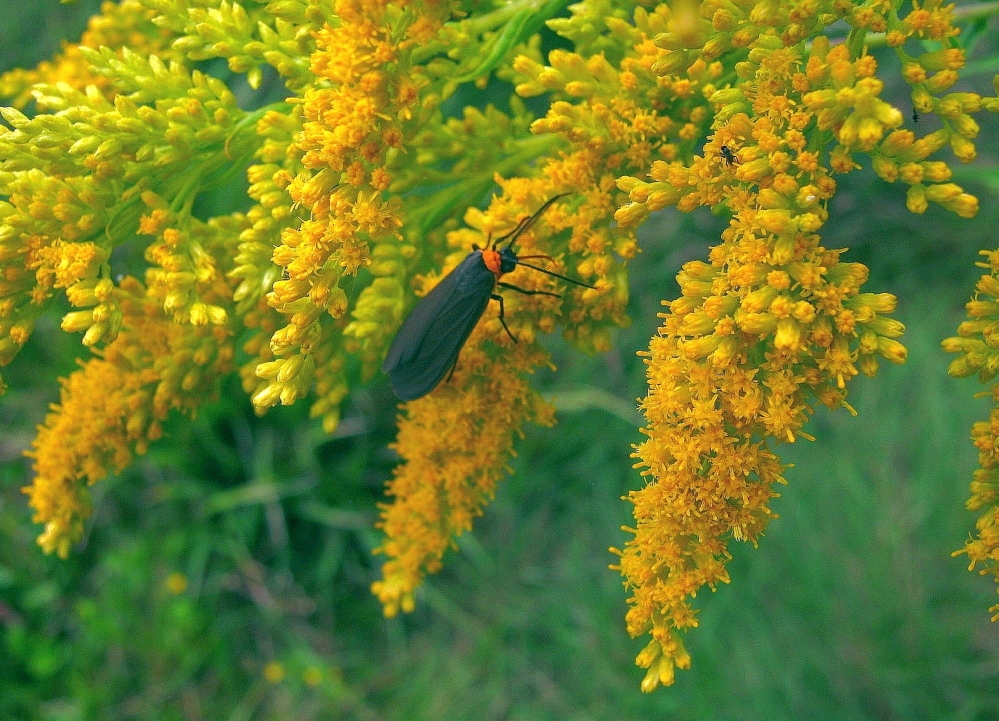Every summer at this time, goldenrod transpires in the fields, spellbinds my eye and leads inevitably to trying to talk about it. Trying to reproduce, or mirror, or evoke it in words as accurately as possible. Every summer I find myself trying out whole new phrases and verbs, and every summer they’re never exactly accurate to the golden facts. I start to feel like the sculptor Alberto Giacometti, who tried again and again to make a nose out of clay that seemed accurate to the spirit of the human form but — in his eyes, at least — never succeeded. So he just kept trying.
So it is with me for the goldenrods. They materialize in July like apparitions in fields and along roadsides. Spraying clusters of tiny bright-yellow flowers, some bent gently over as if weighed down by a breeze, others in cubist sky-pointing arrowheads, and still others flat, almost like their cousin the tansy.
Goldenrod is diverse upon diverse. In the family Asteracea (a weirdly accurate word built from the ancient Greek for “star”) and the genus Solidago (from a Latin root meaning roughly “to make whole or solid”), there are 125 or more species in North America. How many species occur in Maine I don’t know, but it’s more than you can name confidently working only part time.
Their blossoms express five general forms, according to one field guide: plumelike, elm-branched, clublike, wandlike and flat-topped. Most common in my parlance are the rough-stemmed, Canada and lance-leaved goldenrods. Also in our range are sweet, tall, early, late and slender-fragrant goldenrods; stout, showy, downy, gray and hairy; large-leaved, rough-leaved, elm-leaved, blue-stemmed and zigzag; Alpine (on mountains), silverrod, northern bog and seaside; Rand’s and Elliott’s.
No doubt there are more — they have the unusual capacity to cross-breed, some with each other and some even with other Asteraceas. The root of the Canada goldenrod, according to one book, was used by Indians for burns, and the flowers were chewed to ease sore throat; the leaves can be used to make a diuretic, anti-inflammatory tea. The leaves of sweet goldenrod have a scent like anise and make a tea pleasant to the tongue.
Goldenrod energies take form in flowers that feel simultaneously heavy and light, as though they were tough — which they clearly are, as they root practically anywhere sunlight pours down freely and no one hays or mows — but also ethereal, suspended on the air at the tops of their stalks in astounding pyramids, floes and angularities that seem to be emerging from other dimensions entirely.
They fascinate me more than any sculpture. Every summer they stream together in fields or grow alone as if wandering toward a new group. Year in and year out they unceasingly form and re-form living, breathing vitalities of unbelievable complexity and slant. So every summer up pop these verbal weeds, trying to reproduce this perennial facet of summer.
Dana Wilde lives in Troy. He is a contributor to “Pluto: New Horizons for a Lost Horizon” available from North Atlantic Books. You can contact him at naturalist1@dwildepress.net. Backyard Naturalist appears the second and fourth Thursdays each month.
Copy the Story LinkSend questions/comments to the editors.



Success. Please wait for the page to reload. If the page does not reload within 5 seconds, please refresh the page.
Enter your email and password to access comments.
Hi, to comment on stories you must . This profile is in addition to your subscription and website login.
Already have a commenting profile? .
Invalid username/password.
Please check your email to confirm and complete your registration.
Only subscribers are eligible to post comments. Please subscribe or login first for digital access. Here’s why.
Use the form below to reset your password. When you've submitted your account email, we will send an email with a reset code.